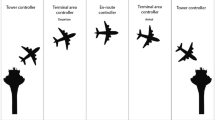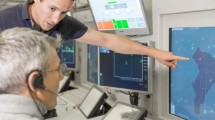Abstract
Sensemaking helps teams coordinate their efforts to understand and anticipate events in uncertain situations. While it is recognized that breakdowns in team sensemaking can lead to incidents, next generation air traffic management (ATM) projects have not paid serious attention to this research topic. This article presents findings from an exploratory field study of team sensemaking in air traffic control for low visibility operations. The study uses the critical decision method and the data/frame model of sensemaking (Klein et al. in Expertise out of context: proceedings of the 6th international conference on naturalistic decision making. Erlbaum, Mahwah, 2007) as a theoretical basis for examining Tower and Approach operations that will be transformed by next generation ATM projects. The findings concern the elicitation of explanatory frameworks for making sense of low visibility operations, the identification of domain-specific strategies that shape sensemaking and the presentation of emergent requirements for team sensemaking. Implications are made for embedding operational experience into future ATM systems to improve collaborative decision making.




Similar content being viewed by others
References
Bearman C, Paletz SBF, Orasanu J, Thomas MJW (2010) The breakdown of coordinated decision making in distributed systems. Hum Factors 52:173–188
Burke CS, Stagl KC, Salas E, Pierce L, Kendall D (2006) Understanding team adaptation: a conceptual analysis and model. J Appl Psychol 91:1189–1207
Cardosi KM (1993) Time required for transmission of time critical air traffic control messages in an en route environment. Int J Aviat Psychol 3:303–314
Committee for Investigation of National Aviation Accidents (CINAA 2011). Final report from the examination of the aviation accident no 192/2010/11 involving a Tu-154M airplane which occurred on April 2010 in the area of the SMOLENSK NORTH airfield. http://mswia.datacenter-poland.pl/FinalReportTu-154M.pdf
Crandall B, Klein GA, Hoffman RR (2006) Working minds: a practitioner’s guide to cognitive task analysis. MIT Press Massachusetts Institute of Technology, Cambridge MA
De Keyser V, Woods DD (1990) Fixation errors: failures to revise situation assessment in dynamic and risky systems. In: Colombo AG, Saiz de Bustamante A (eds). Systems Reliability Assessment, pp 231–251
Endsley MR, Smolensky M (1998) Situation awareness in air traffic control: the picture. In: Smolensky M, Stein E (eds) Human factors in air traffic control. Academic Press, New York, pp 115–154
Federal Aviation Administration (FAA) (2010) FAA’s NextGen implementation plan, March 2010, Federal Aviation administration
Federal Aviation Administration (FAA) (2012) FAA’s NextGen implementation plan, March 2012, Federal aviation administration
Hansman RJ, Davison HJ (2000) The effect of shared information on pilot/controller and controller/controller interactions. Third USA/Europe Air Traffic Manage-ment R&D Seminar, Napoli
Hoffman RR, Crandal B, Shadbolt N (1998) Use of the critical decision method to elicit expert knowledge: a case study in the methodology of cognitive task analysis. Hum Factors 40:254–276
Hoffman RR, Trafton G, Roebber P (2006) Minding the weather: how expert forecasters think. MIT Press, Cambridge MA
Hollnagel E (2007) Flight decks and free flight: where are the system boundaries? Appl Ergonomics 38:409–416
International Civil Aviation Organization (ICAO) (2005) Global air traffic management operational concept, Document 9854 AN/458, 1st eds. International civil aviation organization
International Civil Aviation Organization (ICAO) (2006) Aircraft Operations, Document 8168 ATM/501, Fifth Edition. International Civil Aviation Organization
International Civil Aviation Organization (ICAO) (2007) Air traffic management. Procedures for air navigation services, Document 4444 ATM/501, 15th ed. International civil aviation organization
Kirwan B, Flynn M (2002) Towards a controller-based conflict resolution tool: a literature review (European Air Traffic Management Programme Rep. No.ASA.01.CORA.2.DEL04-A.LIT). EUROCONTROL, Brussels, Belgium
Klein G (1998) Sources of power: how people make decisions. MIT Press, Cambridge
Klein GA (2004) The Power of Intuition. A Currency Book/Doubleday, New York
Klein G, Ross K, Moon B, Klein G, Hoffman R, Hollnagel E (2003) Macrocognition. IEEE Intell Syst 18:81–85
Klein G, Moon B, Hoffman RR (2006a) Making sense of sensemaking 1: alternative perspectives. IEEE Intell Syst 21(4):70–73
Klein G, Moon B, Hoffman RR (2006b) Making sense of sensemaking 2: a macrocognitive model. IEEE Intell Syst 21(5):88–92
Klein G, Philips JK, Rall EL, Peluso DA (2007) A data/frame theory of sensemaking. In: Hoffman RR (ed) Expertise out of context: proceedings of the 6th international conference on naturalistic decision making. Erlbaum, Mahwah
Klein G, Wiggins S, Dominguez CO (2010) Team sensemaking. Theor Issues Ergonomics Sci 11:304–320
Kontogiannis T (2010) Adapting plans in progress in distributed supervisory work: aspects of complexity, coupling, and control. Cogn Technol Work 12:103–118
Kontogiannis T, Malakis S (2009) A proactive approach to human error detection and identification in the aviation and air traffic control. Saf Sci 47:693–706
Langan-Fox J, Sankey MJ, Canty JM (2009) Human factors measurement for future air traffic control systems. Hum Factors 51:595–637
Malakis S, Kontogiannis T (2012) A sensemaking perspective on framing the mental picture of air traffic controllers. Appl Ergonomics 44:327–339
Malakis S, Kontogiannis T, Kirwan B (2010) Managing emergencies and abnormal situations in air traffic control (Part II): teamwork strategies. Appl Ergonomics 41:628–635
Minsky M (1975) A framework for representing knowledge. In: Winston P (ed) The psychology of computer vision. McGraw Hill, New York, pp 211–277
Mogford RH (1997) Mental models and situation awareness in air traffic control. Int J Aviat Psychol 7:331–341
Morrow DG, Lee AT, Rodvold M (1993) Analysis of problems in routine controller-pilot communication. Int J Aviat Psychol 3:285–302
Patterson ES, Watts-Perotti J, Woods DD (1999) Voice loops as coordination aids in space shuttle mission control. Comput Support Cooperative Work: J Collaborative Comput 8:353–371
Piaget JKE (1954) The construction of reality in the child. Basic Books, New York
SESAR Joint Undertaking (SESAR-JU) (2012) European ATM Master Plan, 2 eds. October 2012, SESAR Joint Undertaking
SESAR Joint Undertaking (SESAR-JU) (2009). European air traffic management master plan, 1st eds. 30th March 2009, SESAR joint undertaking
Shorrock ST, Kirwan B (2002) Development and application of a human error identification tool for air traffic control. Appl Ergonomics 33:319–336
Sieck WR, Klein G, Peluso DA, Smith JL, Harris-Thompson D (2004) FOCUS: A model of sensemaking. Fairborn, Klein Associates
Weick KE (1995) Sensemaking in organizations. Thousand Oaks, CA
Weick KE (2007) Making sense of the organizations. Blackwell Publishing, MA
Woods DD, Patterson ES, Roth EM (2002) Can we ever escape from data overload? A cognitive systems diagnosis. Cognit, Technol Work 4:22–36
Author information
Authors and Affiliations
Corresponding author
Rights and permissions
About this article
Cite this article
Malakis, S., Kontogiannis, T. Exploring team sensemaking in air traffic control (ATC): insights from a field study in low visibility operations. Cogn Tech Work 16, 211–227 (2014). https://doi.org/10.1007/s10111-013-0258-7
Received:
Accepted:
Published:
Issue Date:
DOI: https://doi.org/10.1007/s10111-013-0258-7




